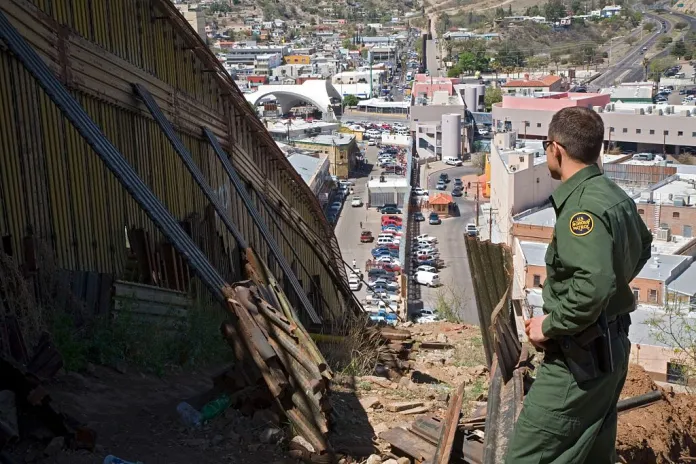Customs and Border Protection is the government agency charged with overseeing all ports of entry in the United States. On a typical day, the last full fiscal year available (2024), CBP processed:
- 3.8 million de minimis (e.g., low dollar) shipments
- 1,150,387 passengers and pedestrians
- 88,582 truck, rail, and sea containers
- 270,800 incoming privately owned vehicles
- $9.2 billion worth of imported products
- 105,103 entries of merchandise
- $241 million in duties, taxes, and other fees
Underlying those numbers are countless stories. When the CBP held a media availability at Blaine, Washington’s commercial truck crossing in June, it was hard to know exactly what to expect. A taxidermied bald eagle certainly was not on the list.
The eagle had been hunted and killed in one province of Canada, legally, agents said, and duly declared at the border as the owner tried to import it into America. There was no violation of law involved, and thus no fines or other penalties were assessed.
However, it is next to impossible for a private individual to import a bald eagle into the country, due to the Endangered Species Act and other legislation. The owner had been given the option of sending it back, but had elected to abandon it at the border instead. Thus, the dead, preserved adult eagle, mounted on a wild wooden base, was brought out to pose for the cameras and flashbulbs.
The official moral of the story was that people who want to bring something over the border that is legally questionable should call first, to save themselves a great deal of hassle if it is not allowed in the country.

Agents for both CBP and the U.S. Fish and Wildlife Service — though not the Border Patrol — also had many other stories about animals coming through the border, legally and illegally.
These stories included attempts to smuggle in parrots, in bras, and liquored up; animal actors from monkeys to bears traveling through the Blaine port to do movies; and, during one discussion of strange imported meats, cooked rats on a stick.
Agents also had stories about smuggling, mostly of drugs, in hot tub covers, teddy bears, sweet potatoes, and bicycle tires, as well as weird intellectual property stories. Mickey Mouse piñatas and painted starfish Christmas ornaments that were “confusingly similar” to characters from SpongeBob SquarePants have been denied entry.
Off the record and organized crime
It was tremendously fun and informative stuff, in other words, but then came the kicker. Near the end of the event, after this writer had taken 17 pages of notes, one speaker insisted that all of this was, and had been, off the record.
The event had not been advertised as off the record. Though one of the ground rules stipulated “no recording,” a stipulation the Washington Examiner observed, that is a wholly different thing from being off the record. Another reporter who was there confirmed this.
“I remember thinking it was puzzling that they would have a media academy where they wanted us to ‘tell their story’ and yet none of them could be on the record,” the reporter told the Washington Examiner in an email after, adding, “Luckily my editors had no expectation of me filing from that session, because I’m not sure what you’re supposed to do with an all-day off-the-record event.”
Going on and off the record is a journalistic convention that requires a specific kind of agreement between reporter and source. Usually, the source specifically asks to talk off the record. Even then, the source must first receive agreement from the reporter before it becomes ethically binding, though reporters often extend some latitude on this last point to people unaccustomed to dealing with the press.
Nothing like that happened at the Blaine border media academy until near the end, which would place any of the proceedings behind a barrier of anonymity or secrecy or anything of the sort. However, one story agents told both illuminated the nature of their work and provided a good reason to extend some anonymity anyway.
Agents of organized crime keep logs on agents who screen passengers. We know this because a few of these logbooks have been seized in various ways and turned over to U.S. authorities. Some of these logs can be scary in the amount of information that they have on U.S. customs agents. It thus makes good sense, when possible, not to make that nefarious business any easier.
Why Customs is different
Border Patrol was not present at the meeting, likely because its job is so different from Customs and Border Protection. Border Patrol is a law enforcement agency first and foremost. It finds people who have quite literally crossed a line that they should not have by law and punishes them for it, usually through a mix of arrest, incarceration, and deportation.
Customs is different, starting with how it views itself. From discussions, agents described CBP as a regulatory agency first and a law enforcement agency second. Its job is to facilitate trade that the U.S. government deems legitimate quickly and efficiently, and to screen out criminals and contraband, and bad actors in the process.
The full numbers for fiscal 2025 are not yet available on the CBP website. With reporting through the end of August, we can see 11/12ths of the picture, which is still valuable. In that 11 months, the agency oversaw the importation of goods valued at $3.31 trillion; 43.1 total entry summaries (roughly, larger, more expensive shipments); 945.3 million goods shipped under the de minimis category (roughly, smaller, cheaper shipments); and $195.9 billion in collected duties, taxes, and fees.
Over that same period, CBP seized 50,100 lbs of drugs of all types, including 21,200 lbs of marijuana, 2,700 lbs of meth, 2,200 lbs of cocaine, and 891 lbs of fentanyl. Intellectual property seizure numbers are not yet available for the last year. In the previous fiscal year, CPB seized 20,631 shipments from all over the world with 32.3 million units, with an MSRP of $5.4 billion.
Customs and Trump
When Washington, D.C. resident and then-Justice Department employee Sean Dunn, allegedly approached a group of federal agents who were patrolling the city as part of the temporary federal law enforcement takeover of the city in August, called one of them a “fascist,” and threw a sandwich, he allegedly managed to hit a member of the CBP square in the chest. This was far afield of what Customs agents would normally be doing, but some things are changing under the Trump administration for CBP.
Changes in the nature of international trade that President Donald Trump’s administration is insisting upon largely fall to the CBP to oversee. In the most famous example, the president has unilaterally hiked tariffs significantly on most nations — and one island populated entirely by penguins.
First announced in April, the tariff hikes are starting to show up in the agency’s collections in a big way. Total duties, taxes, and fees rose from $88.07 billion in fiscal 2024 to $195.9 billion for most of 2025.
Then there are the de minimis shipments, which have been at least temporarily phased out. Total units shipped to Americans for the same periods fell from 1.36 billion to 945.3 million over the same almost two-year period. De minimis was a cheap way for Americans to purchase goods from other countries, which the CBP facilitated. Without that categorical exemption, expect millions of Americans to feel some pain in their pocketbooks.
There is also the large matter of the border wall. As part of its day-to-day operations, the CBP handles logistics on a large scale. This may explain why it has been charged with overseeing the construction of a wall to halt unauthorized traffic along part of the U.S.-Mexico border.
SANTOS SAYS HE’S ‘VERY GRATEFUL’ FOR TRUMP COMMUTATION, WANTS TO PURSUE PRISON REFORM
Trump’s signature One Big Beautiful Bill Act, signed into law in July, authorized over $50 billion of funding for barrier construction. CBP announced the first round of contract funding, $4.5 billion, in September, for what is called a “Smart Wall” project. This will be a border security system that “combines steel barriers, waterborne barriers, patrol roads, lights, cameras, and advanced detection technology,” the agency said in a news release.
In total, that should add “230 miles of Smart Wall and nearly 400 miles of new technology” to the southern border, CBP said. It will be largely the Border Patrol’s job to secure that area when construction has finished. Yet that increased security promises to shift a significant amount of illicit traffic toward official portals of entry.
Jeremy Lott is the author of many books, most recently The Three Feral Pigs and the Vegan Wolf.























